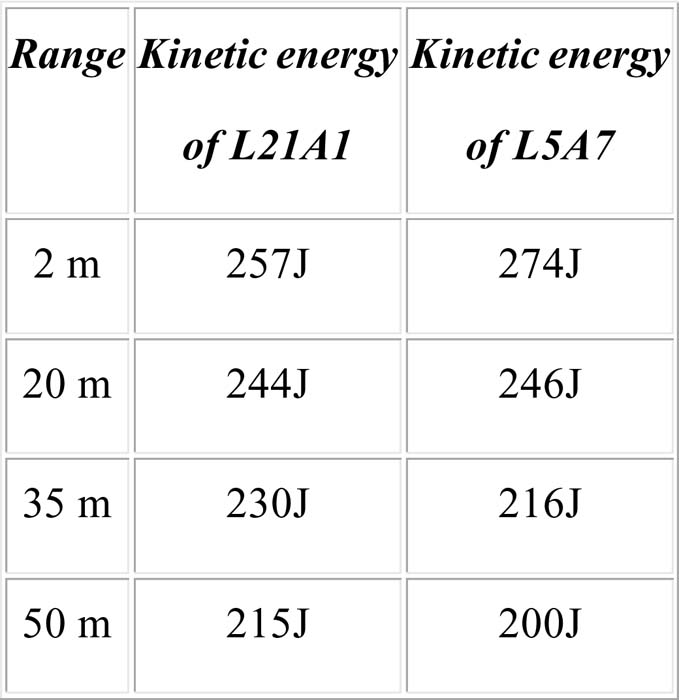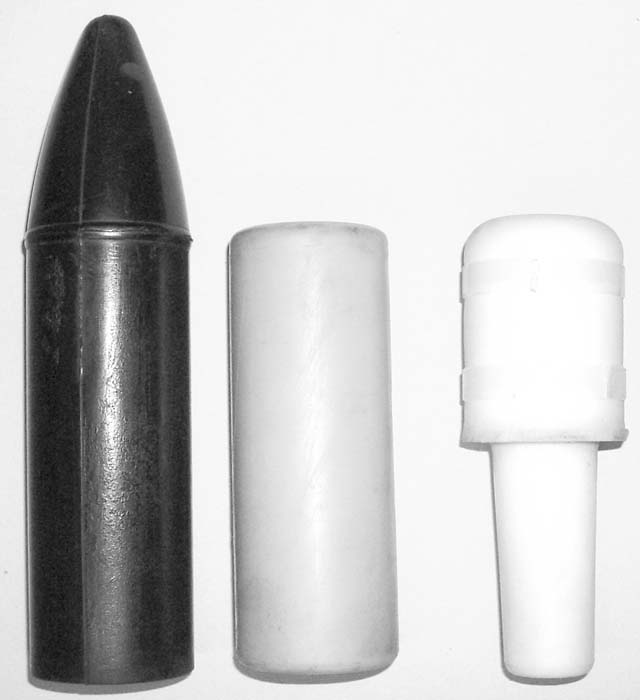By Anthony G. Williams

At the end of the 1960s, tensions between the Catholic and Protestant communities in the British province of Northern Ireland, which had been simmering for some time, erupted into violence. Among other things, this faced the police and the army with major crowd control problems, particularly since protesting crowds frequently contained (and sometimes still do contain) members who attacked the police with bricks, fire bombs, blast bombs and even firearms. It was important to find ways of combating such attacks without using lethal ammunition, which would cause too many deaths and thus inflame the situation even more. The police and the army therefore adopted various tactics and less-lethal weapons in order to break up violent demonstrations and target specific trouble-makers within them. While CS gas and water cannon have been used against crowds in general (and water cannon still are), the need to target specific individuals within the crowd led to the adoption of 37mm calibre riot control guns firing baton rounds (nowadays known as impact rounds).

The problem facing the designers has been how to make a projectile which will hit with disabling impact out to beyond the crowd’s object-throwing range, without being lethal at short range. They have achieved this by adopting big, heavy, low-velocity baton projectiles. An advantage over smaller-calibre projectiles is that they are big enough to minimize the chance of entering an eye socket and penetrating the brain. The normal operating range for a baton round is 20-40 meters, but they may be fired at much shorter ranges in an emergency. These batons are designed to be fired at the abdomen and legs (the latter particularly at short range), as there is a risk of serious and potentially fatal injury if they hit the chest or, especially, the head. Over the period 1970-2005, some 125,000 baton rounds have been fired in Northern Ireland. These have resulted in 17 deaths, the last being in 1989. This works out at an average of ten rounds per day and one death every two years, or a death rate of 0.0136%.
Until recently, these weapons were not used in other parts of the UK, but in 2001 (in conjunction with the introduction of the L104A1 gun and L21A1 round) it was decided to make them available to police forces outside Northern Ireland. In these areas they have not so far been used in riot situations, but as an alternative to lethal weapons against individuals who are posing a threat to others. Between 2002 and 2004, some 50 baton rounds were fired in England and Wales in 37 separate incidents. The ranges varied between 1 meter and 25 meters, and 94% hit their target (compared with 67% for lethal firearms). No deaths or serious injuries resulted.
The baton rounds have evolved over the last 35 years and this article describes the major types used.
“Rubber Bullet”

This was the original baton round used from the late 1960s until about 1975. It uses the same case as the standard 1.5 inch/38mm flare gun cartridge, but loaded with a long, pointed, rubber baton. The case is 122mm long with a rim diameter of 43mm and an outside body diameter of 39.4mm near the rim, stepping down to 38.6mm at a height of 22mm above the rim. The baton is 149mm long and weighs 174g. The gun was smoothbored.
L5 Plastic Baton Round
This plastic baton round, or PBR, was introduced in 1973 and replaced the rubber bullet within two years. It was initially known as the “1.5 inch” round. This used a similar 37×122 cartridge case, except that the outside diameter remains at 39.4mm throughout. The obvious difference is that the baton is flat-nosed and made from polyurethane polymer. The L5 remained in service for a long time and went through several marks, the last being the L5A7. The baton is 98mm long, weighs 131g and is fired at 63 m/s.
L21A1 Plastic Baton Round
This PBR was a new departure, introduced in 2001 in conjunction with a new riot control gun, the L104A1 made by Heckler & Koch. This gun has a rifled barrel, which in conjunction with the X1 18E3 optical sight and more consistent ammunition performance provides far greater accuracy. (When fired from smoothbores, the earlier rounds tend to tumble in the air). The cartridge case is slightly shorter at 103mm, and the baton has more rounded edges to achieve a longer effective range. However, the Defence Scientific Advisory Council concluded as a result of tests that the L21A1, although delivering similar impact energies to the L5A7, could be slightly more dangerous if it struck the head. The baton weighs 98g and is fired at 72 m/s.
AEP L60A1 Impact Round
This was introduced in June 2005 to replace the L21A1. It was developed to reduce the risk of inflicting death or serious injury from a head strike, and achieves this by incorporating a hollow nose. On impact with soft tissue this remains intact, but on striking a hard target like the head or breast-bone, it deforms to reduce the peak impact by between one third and a half. This round is known as the AEP, which stands for Attenuated Energy Projectile. The cartridge case, projectile weight and muzzle velocity remain the same as the L21A1, but the case is painted light grey instead of the black of earlier baton rounds. The AEP is claimed to exceed 95% accuracy against a 400mm x 600mm target at 50 meters.
Ammunition Manufacturers
The British government does not release information about the manufacturers of baton rounds, probably because they have always been (and remain) controversial in Northern Ireland, due to the deaths and serious injuries which their use has occasionally caused. However, it is known that substantial orders for baton rounds have been placed in Germany. In the 2004/5 financial year, a German company or companies supplied 34,272 L60A1; 267,276 L21A1; and (surprisingly) 50,000 L5A7 rounds. The cost of the baton round is approximately £7 each.
ARWEN Ammunition
The ARWEN (Anti-Riot Weapon ENfield) was developed by Royal Ordnance UK and introduced in 1977. However, the rights to manufacture the guns and ammunition were purchased from Royal Ordnance in 2001 by its Canadian distributor, Police Ordnance Company Inc., which continues to offer them to the law enforcement market. These guns were not selected for use in the UK. Unlike the riot guns used by British police, which are single-shot, the ARWEN 37 family all have a rotary magazine containing five shots, which can be fired in four seconds.
This round is really an “odd one out” as it is incompatible with any other 37mm riot control ammunition, with the exception of a similar range made by Sage Control Ordnance of the USA. It uses a rebated-rim case which is 112mm long. The outside diameter of the case is 39.7mm but the rim measures only 32.2mm. The single projectiles all have a characteristic “tadpole” shape, with the 37mm diameter front section just 50mm long; followed by rear section of similar length which tapers from about 24mm to 20mm. The standard AR-1 baton round projectiles weigh 80g and are fired at 74m/s; they are claimed to have an effective range of 20-100m. Various different loadings are available including a reduced-energy AR-1RE (50 m/s: effective range 1-30m); and a number of combined (chemical + impact) rounds including ones firing four cylindrical sub-projectiles.
Other 37mm/38mm and 40mm Riot Control Ammunition
There is much confusion over the calibres and calibre designations of riot control rounds. Calibres of 37mm, 38mm and 38.1mm are mentioned in manufacturers’ data. In fact, 38.1mm is a straight conversion from the original 1.5 inches. In British use, these have been renamed 37mm because 36-37mm is the actual diameter of the baton. Actual measurements from manufacturers in different countries do vary, but the nominal designation does not help to determine this. Some guns are made to deliberately “sloppy” tolerances so they can fire any 37/38mm ammunition (except for the ARWEN rounds), but with obvious implications for their performance and accuracy.
Armies tend to prefer 40mm rounds which can be fired from their standard grenade launchers, and a range of these has been developed. One maker (Condor of Brazil) offers multi-calibre rounds which can be fired in 37/38mm or 40mm guns. Some 40mm riot-control rounds are extra-long (228mm rather than 122mm) and cannot be fired from all grenade launchers, as there isn’t enough clearance for them to be inserted.
Riot control ammunition – whether 37mm or 40mm – can of course be loaded with projectiles other than plastic batons. Other impact rounds include wooden batons, foam batons, multiple batons, bean bags and rubber balls of various sizes. The US Army uses the M1029 40mm Crowd Dispersal Round, which is loaded with forty-eight rubber balls, each .48 of an inch in diameter. However, like the chemical projectiles (containing various types of tear gas or pepper), these are “area weapons” intended for general crowd dispersal rather than targeting particular individuals. There are also dual-purpose (impact + chemical) rounds intended for use against individuals.
There will always be a need to temporarily disable specific rioters, or anyone posing a danger to others, in situations where lethal force is not appropriate. The latest generation of ammunition is better than ever in terms of both precision targeting, and reducing the risk of death or serious injury.
(I am indebted to Colin Burrows, the Director of Critical Intervention Consultancy Services, and Loui Burke, the Managing Director of Primetake Limited, for providing information used in this article, but any errors are entirely my responsibility.)
The author is Co-editor of Jane’s Ammunition Handbook.
| This article first appeared in Small Arms Review V11N11 (August 2008) |











